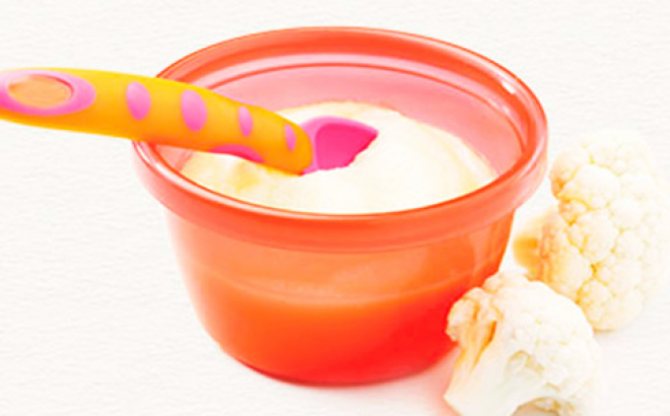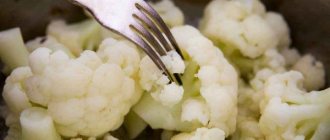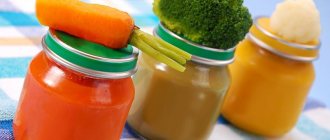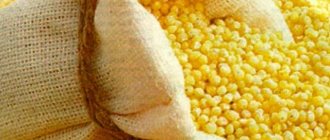Pediatricians recommend starting vegetable complementary foods with cauliflower. What properties allowed this culture to take such an honorable first place?
Photo: depositphotos.com. Author: bit245.
The traditions of introducing complementary foods are different everywhere. In the CIS countries, vegetables, milk porridges and fermented milk products are competing for the top spot.
But the choice should be based not only on the mother’s opinion, but also on the baby’s health status:
- For bloating and diarrhea, complementary feeding begins with cereals.
- For intestinal colic and constipation, or exceeding the age norm for body weight, choose vegetables.
You need to start with what is grown in your region.
Give preference to white or green vegetables: they contain non-coarse, easily digestible fiber.
Choose hypoallergenic crops, even if the little one is not prone to allergies - it will be easier for the immature digestive tract to cope with them.
If the first vegetable complementary food is started correctly, the child will not face any unpleasant consequences. In the future, this will help the baby adapt to any solid food: from zucchini puree to meat.
pros
Why pediatricians choose cauliflower:
- rarely causes allergies;
- pleasant to the taste;
- easy to digest;
- Compared to cabbage, it contains less fiber: lower risk of bloating;
- the composition includes minerals: phosphorus, potassium, iodine, magnesium, iron and cobalt;
- rich in vitamins A and C (three times more compared to white cabbage varieties), B, E, K, H, PP - compounds that make the baby’s body more resistant to viruses and have a beneficial effect on its overall health;
- contains easily digestible vegetable proteins necessary for the functioning of the liver and gall bladder and the full development of the child;
- strengthens bones;
- improves metabolism;
- increases the strength and elasticity of vascular walls;
- useful for babies with high blood sugar.
When is it allowed to be introduced into complementary foods?

Cauliflower is easily accepted by the gastrointestinal tract of both adults and children. It is quickly digested and does not cause bloating, belching or heartburn. This is why nutritionists love her very much. In combination with its rich chemical composition and low calorie content, this vegetable is an indispensable product for the first feeding of infants.

You can introduce it into your baby’s diet immediately after green zucchini, starting at 6-7 months.
This recommendation applies to healthy breastfed or bottle-fed babies whose weight corresponds to the norm - girls at 6-7 months of age weigh on average 6.5-7.5 kg, and boys at the same age are slightly heavier - 7-8 kg. If the child is underweight, suffers from diarrhea and flatulence, and regurgitates heavily, then the issue of introducing cauliflower into complementary foods should be discussed with the pediatrician.
The best way to prepare cauliflower for baby food is not to boil it, but to steam it.
Steaming cauliflower retains most of its nutrients. Baked or boiled cauliflower are also cooking options.
The main function of the first complementary food for a baby is to enrich the growing body with vitamins and minerals. The choice of vegetables for the first complementary feeding should be discussed with your pediatrician and selected individually for each person.
We suggest you read: How to store carrots for the winter

Cauliflower puree
Cauliflower is ideal for first feeding due to its easy digestibility and the presence of a wide range of vitamins and minerals. Thanks to the fiber, cabbage has a beneficial effect on the child’s digestion. Cauliflower contains the following useful components:
- vitamin C
- carotene
- potassium
- magnesium
- phosphorus
- easily digestible proteins
- rich in amino acids
- mineral salts
- carbohydrates
- B vitamins

Child eats cauliflower puree
- Cauliflower has invaluable benefits during the first feeding if the baby suffers from constipation and increased gas production
- If your baby is allergic, cabbage will help relieve all symptoms of food allergies and reduce the location of rashes
- In addition, the use of cabbage for complementary feeding prevents iron deficiency anemia
- Phosphorus and minerals in cabbage have a beneficial effect on the functioning of the liver and gallbladder
- Doctors evaluate the beneficial effects of such complementary feeding due to the normalization of the baby’s blood composition, strengthening the walls of blood vessels
To prepare cauliflower puree for the first feeding, first select and buy clean and fresh cabbage without stains. It is advisable to always purchase fresh cabbage, and only frozen cabbage as a last resort. The freezing process removes the bulk of vitamins and microelements from vegetables.
Pay attention to the main characteristic features of the appearance of cabbage:
- cabbage color should be ivory
- leaves are bright green and clean
- there should be no darkening or defects
- The cabbage itself is elastic, and the inflorescences are densely planted
- To prepare vegetable puree, rinse the food thoroughly under running warm water.
- If necessary, clean the vegetables with a brush.
- Separate the florets for cooking
- The cooking process is carried out in pre-boiling water.
- It's better not to add salt
- After cooking, the cauliflower is chopped with a blender or rubbed through a sieve.
- The consistency of the finished puree should resemble kefir in thickness. Not thicker, as the child may refuse to try a portion of complementary foods.
- If the puree turns out to be very thick, dilute it with breast milk or broth from cooking cabbage.
The best nutrition for a baby is mother's milk. Therefore, the question often arises: from how many months can a baby eat cauliflower and how to introduce cauliflower into complementary foods? When breastfeeding, complementary feeding can be started from 5.5 to 6.5 months.
Mother's milk still copes with all the needs of the child's body, so there is no need to worry that the child will not receive enough nutrients. Don't rush into starting complementary feeding.
- For the first feeding, vegetables that grow traditionally in your area and are not brightly colored are suitable;
- You can start with purees of the required consistency or give your child a microdose of boiled cauliflower;
- A microdose is a small piece, the size of a grain of rice;
- The child will try a new taste, try to swallow;
- The food will enter the stomach and trigger the production of the necessary enzymes for digestion;
- If you give your child food in a piece, you will see that it will come out undigested. However, the same thing happens with purees, just because of the liquid consistency, you won’t be able to see it in the baby’s stool.
Read more about this in the article Stool after the introduction of complementary foods{amp}gt;{amp}gt;{amp}gt;.
What does this tell us? The gastrointestinal tract is only training and the child is not ready to take large amounts of food.
- During the season, it is advisable to make puree from fresh cauliflower. You can easily get by with your own preparation:
- First you need to puree one vegetable;
- After, by seven months, prepare a combined puree of vegetables that you will be completely confident in.
- If the introduction period falls in the winter: canned food or preparation from frozen vegetables is used. I’ll tell you below how to freeze cabbage to feed your baby.
Jars are convenient for travel or when force majeure occurs in the house. In this case, canned food is very helpful.
By the way! I would not recommend constantly feeding your child canned foods, because nothing compares to freshly prepared purees from properly selected products.
If you have chosen to puree the cabbage for now, then grind it to the required consistency using a blender.
Pedagogical
This is a new approach to getting to know adult food, developing interest in new tastes and eating independently.
In pediatric cases, everything is calculated according to plan: time, volume, type. When teaching, there are no strict rules - you feel your baby.
- The main difference is that food is not prepared separately. Your diet mainly consists of foods that are allowed for your baby. For example: soup without sauteing and frying, without fatty meats, etc.;
- The child, together with his parents, tries “adult” food in micro doses. You cannot force your baby to eat. He is just getting acquainted, the main food is mother's milk;
- With pedagogical complementary feeding, with age there is no need to grind food. When your baby can chew, he becomes familiar with solid foods and learns to swallow;
- At five months of age, the tongue pushing (spitting) reflex disappears. The baby can already sit up, chew and digest food;
- At first he sits in his mother's arms. After trying one product, you need to take a break for a couple of days to see a negative reaction if it appears;
- Over time, the number of microdoses increases. The baby can already sit independently in his own place (chair) and use his own plate.
It is a great joy for him to do what mom and dad do! Breastfeeding doesn't stop.
- The main task of pedagogical complementary feeding is gradual adaptation to adult food, to its consistency and taste. By the age of one year, the volume of food reaches several spoons.
What should you pay attention to with this type of complementary feeding?
- Your child's condition;
- Presence of allergic reactions;
- The health of parents or other family members from whose plate the baby eats;
- Eating healthy foods. The parental diet should consist of foods allowed for the small family member;
- Products that are prohibited for the baby (smoked meats, sweets, etc.) are not allowed to come into contact with the eyes.
According to the recommendations of modern pediatricians, the first complementary foods begin to be introduced at 6 months. Early complementary feeding may adversely affect the child's digestive system. But with artificial feeding you can start at 5 months.
In addition, the child must begin to be interested in the food of adults, be able to hold his head confidently and sit. The presence of teeth is not a necessary sign, but it is also a signal to introduce complementary foods.
Cauliflower for the first feeding is given in the form of puree; you don’t need a lot of it. Half a teaspoon is enough. Sometimes the baby refuses the food offered. Don't insist, offer it the next day. The baby is unfamiliar with such food, and this repels him. He needs to get used to it. To do this, you can add a little familiar food to the cabbage puree - mother's milk or formula.
The introduction of a new product always begins in the morning. This is due to the fact that it is easier to identify the body’s reaction to it during the day, be it an allergy or a digestive disorder. The reaction may appear after 3 hours or even within 12 hours. Therefore, it is necessary to monitor the child.
Your own food or store bought?
Ready-made canned complementary foods require a minimum of hassle. It is recommended by WHO experts, citing its balanced composition, which is difficult to reproduce at home.
It is important to check the expiration date and tightness of the container. And look at the composition: there should be only water and vegetables. The presence of starch, milk, maltodextrin, salt and spices indicates low quality.
An opened jar is a fertile environment for harmful microbes. Therefore, experts recommend feeding your baby puree from a jar only once: immediately after opening it. The product is not suitable for repeated use.
To prevent baby food from ruining the family budget, use a compromise option: put a little puree from the jar onto a plate or cup with a clean spoon, then close the container tightly with a lid and put it in the refrigerator, but for no more than a day.
Benefits of cauliflower
Cauliflower contains a lot of useful substances. It contains vitamins such as A, C, group B, PP and such a rare one as U. Thanks to them, metabolism, immunity, hemodynamics, the condition of the skin, hair, nails, digestion are improved, it has a beneficial effect on the nervous system, and regulates the functioning of the thyroid gland. glands. Methionine (vitamin U) regulates the acidity of gastric juice, restores the intestinal mucosa, and has a calming effect.
It also contains many micro- and macroelements (calcium, magnesium, iron, selenium, potassium, phosphorus and others). They help in the treatment of anemia, cardiovascular diseases, promote proper growth and development, and mental activity.
We invite you to read: Recipe for sauerkraut with apples
Making puree at home
There are parents who only accept home-prepared complementary foods. Indeed, homemade food has advantages: mom doesn’t have to worry about quality and cooks exactly as much as needed every time.
You can buy fresh or frozen cauliflower. In the second case, pay attention to the amount of ice and the indicated shelf life. There are fewer vitamins in a frozen product, so use fresh vegetables whenever possible.
- Choose ivory-colored specimens without black spots or other visible damage.
- Tear off small inflorescences from the head of cabbage and leave in water for 20 minutes to get rid of possible insects. Before preparing complementary foods, it is recommended to leave store-bought cabbage in cool boiled water for 4 hours: during this time, pesticides and other harmful substances will leave it.
- Rinse the inflorescences thoroughly and brush with a brush under running water, then disassemble into components.
- Throw into boiling water and cook for 7-10 minutes, preferably in an enamel bowl. No need to add salt.
- Grind in a blender or with a fork, then rub through a special strainer for complementary feeding.
- The consistency should be approximately like that of kefir, otherwise the child may refuse complementary feeding. Bring the finished puree to the required thickness with vegetable broth or breast milk. Infant formula is also an option.
Prepare a new portion for each meal. Preparing puree in a slow cooker will take 25 minutes, in a double boiler - at least 15 minutes with the correct mode, in a microwave oven - 7-10 minutes, depending on the power.
How to cook broccoli for first feeding?
Recipes for children
Cauliflower goes well with many vegetables, so the children's menu can be easily varied with tasty and healthy dishes. Below are some popular recipes.
Cauliflower soup for baby (from 10 months)
To prepare the first dish you will need 2-3 inflorescences, a small potato, 20 grams of carrots, 20 grams of onions, 200 ml of water.
All ingredients must be thoroughly washed, peeled and cut. Bring a saucepan with water and potatoes to a boil on the stove, reduce heat and simmer for 7 minutes. Then add the remaining vegetables and cook for another 10 minutes. Pour the broth into a separate bowl, and mash the prepared soup ingredients with a masher or blender until smooth. Pour the broth into the puree, put it on the stove and boil.











